All set for Customs Headquarters opening
by Kurulu Koojana Kariyakarawana
The Sri Lanka Customs headquarters building at the Chalmers Jetty in
Colombo Fort will be opened on July 14 by President Mahinda Rajapaksa
who is also the Minister of Finance.
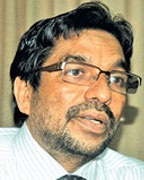 |
Customs
Director General
Jagath P Wijeweera |
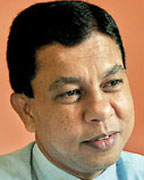 |
Director of
Customs BCNP
Samantha Gunasekara |
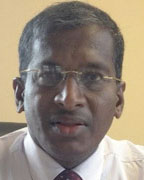 |
| Customs
Spokesman Director Leslie Gamini |
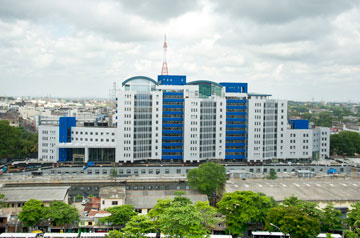 |
| New Customs
Headquarters at No. 40, Main Street on the Chalmers Jetty |
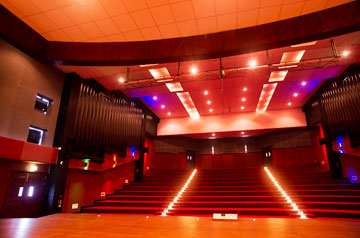 |
| The state of
the art auditorium |
Construction of the 13- storey building commenced in November, 2005
when President Mahinda Rajapaksa was the Prime Minister. He laid the
foundation stone a few days prior to being appointed as President.
Leading construction agency Maga partnering with the State Engineering
Corporation completed the mega project in May 2012 at a cost of Rs.4.2
billion.
Sri Lanka Customs did not have a permanent office building for many
years and was housed in numerous places including the Ports Authority,
old Times of Ceylon building and Grindlays Bank building in Fort. In
2005, a land was allocated by the Government on the Chalmers Jetty where
the old Chalmers warehouse was situated next to the Chalmers Granary, to
build the new headquarters.
Customs spokesman, Director Leslie Gamini told the Sunday Observer,
the building is of national importance as it has enabled a vital
government institution to bring together its administrative divisions
and human resources base, previously scattered across the city to a
central location in its 430, 000 sqft floor area spanning 13 floors.
The state- of- the-art modern building with ample office space will
bring over 20 directorates of Customs that functioned in various places
under one roof. The public can now obtain the services of the Import and
Export Divisions, Central Valuation Division, Appeals Division and
Consumer Protection Division without any hassle.
It is also convenient for investigating officers to conduct their
duties as the main monitoring divisions such as the Central
Investigation Division, Central Intelligence Division, Preventive
Division, Narcotics Division, Bio Diversity, Cultural and National
Heritage Protection Division (BCNP) and Legal Affairs Division are also
situated in the same premises.
Sri Lanka Customs has a history of over 200 years as a department
since 1809 to 2009. The department was established in 1806 and the first
Comptroller General was appointed in 1809 as the organisational head.
This title was soon changed to Principal Collector of Customs until 1988
which again was changed to Director General of Customs. The incumbent is
Jagath P Wijeweera.
The Customs Museum, a one- of- a- kind place showcasing the
Department's long-standing history and exhibiting the samples of various
unlawful items detected in the course of time, will also be opened for
the public on the same day.
Director of Customs BCNP, Samantha Gunasekara said the concept to set
up a museum for the Customs Department was a long felt requirement,
especially to educate the public about the role of the Department as
well as its history and detections being carried out.
Apart from the 200-year-old history since the setting up of the Sri
Lanka Customs Department in June 1806, customs operations dates back to
1000 years to the Maha Parakramabahu king's era, where foreign goods
were imported into the country through ancient trading channels like the
Silk Route.
Then Sri Lanka was known as Serendib or Taprobane and was a dominant
country situated in the maritime trading routes where the Customs was an
essential duty to be carried out. Proof of this operation has been found
written on ancient stone inscriptions, he said.
Prior to the opening of the Headquarters building, a special Customs
Awareness Week has been organised to educate the schoolchildren from
July 7 to 12.
The six-day awareness program will educate schoolchildren about many
aspects of the Sri Lanka Customs including its history, operations,
duties and responsibilities as a state organisation.
School children will be educated on six main topics about the Customs
and its operations on each day. On July 7, the history of the Customs
will be explained. Although the Customs was institutionalised for over
200 years, the history of taxing and collecting revenue from foreign
importers dates back to the First Century AD, according to the Godawaya
Inscription in Ambalantota.
On the second day, the Economic Factor of the department including
the collection of revenue will be explained. Over 57% of state revenue
on taxation is earned by the Customs which will be spent mainly on
national infrastructure development work.
The element of social protection will be explained on the third day.
Prevention of hazardous material flowing into the country such as
narcotics, dangerous drugs and sub standard food etc. will be monitored
by the Customs.
Awareness on Trade and Travel Facilitation will be made on the fourth
day, how legitimate importers are granted tax concessions as an
encouragement and duty relief facilities for tourists such as duty free
shops will be explained to students.
The enforcement of law is another important feature that would be
explained on the fifth day.
Smuggling and illegal trading is a tactic adopted since ancient
times.
It is the responsibility of the Customs to arrest and take legal
action against people who smuggle narcotics, jewellery and gold,
hazardous material and prohibited wildlife, Fauna and Flora.
Innovation and evolution of the present day Customs will be explained
on the final day. Many services like the Customs Declaration (Cusdec)
documents have been electronically made to meet the e-systems of the
modern day.
The Awareness Week will be held at the Customs Auditorium. Deputy
Minister of Finance and Planing Dr. Sarath Amunugama, Customs Director
General Jagath P Wijeweera, officials of the Ministry of Finance and
Senior Customs officers will be present. |

